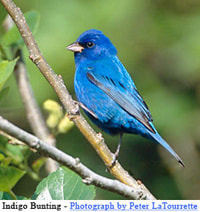Elk Rapids Almanac: May 2019
May 1 – Today there were six loons happily swimming just below the hydro power plant. -Christine Petersen.
May 17 - Three indigo buntings and a female oriole have been frequent visitors to the feeders in the yard. They love the millet! -Terri Reisig.
May 17 (Then they go next door and feed on the neighbor's millet!) -Royce Ragland.
May 27 - Fourteen species of birds were identified in the back yard today. Toward evening, gold finches and mourning doves appear in greater numbers as the more aggressive blue jays and blackbirds retreat to their nests. -Ken Bloem.
NOTE: Many spectacular migrating songbirds, like the Indigo Bunting - and others such as warblers, orioles and thrushes - are experiencing population declines. Most of these species depend on insects for at least part of their needs, and all must have insects to feed their young. By and large, native plants host those insects. It is the goal of Saving Birds Thru Habitat to improve habitat for these migrants, one backyard at a time. -Kay Charter, Saving Birds Thru Habitat. savingbirds.org
NOTE: Kay Charter has opposed offering jelly to orioles for decades, learning from Kent McHaffey, manager of San Diego's Wild Animal Park, that high sugar products can set a bird's crop up for bacterial infection. He added that he would never offer a bird something that is not made from ingredients in its natural diet.
The Effects of Pesticides: Spraying your home and garden with pesticides for spiders, or your trees for tent worm caterpillars, has an effect on songbirds and other wildlife. Insecticide toxicity is broad and indiscriminate. Insecticides are ordinarily applied to treat for one or two insects, but everything in nature is connected. When you affect one population, it has a ripple effect across species that depend upon and coexist with that population. Spraying insecticides kill those things you don't like, but also kills all other insects, including bees and butterflies. Even so-called "green" chemicals are toxic to other organisms, including you, your children and your pets. _Kay Charter.
May 1 – Today there were six loons happily swimming just below the hydro power plant. -Christine Petersen.
May 17 - Three indigo buntings and a female oriole have been frequent visitors to the feeders in the yard. They love the millet! -Terri Reisig.
May 17 (Then they go next door and feed on the neighbor's millet!) -Royce Ragland.
May 27 - Fourteen species of birds were identified in the back yard today. Toward evening, gold finches and mourning doves appear in greater numbers as the more aggressive blue jays and blackbirds retreat to their nests. -Ken Bloem.
NOTE: Many spectacular migrating songbirds, like the Indigo Bunting - and others such as warblers, orioles and thrushes - are experiencing population declines. Most of these species depend on insects for at least part of their needs, and all must have insects to feed their young. By and large, native plants host those insects. It is the goal of Saving Birds Thru Habitat to improve habitat for these migrants, one backyard at a time. -Kay Charter, Saving Birds Thru Habitat. savingbirds.org
NOTE: Kay Charter has opposed offering jelly to orioles for decades, learning from Kent McHaffey, manager of San Diego's Wild Animal Park, that high sugar products can set a bird's crop up for bacterial infection. He added that he would never offer a bird something that is not made from ingredients in its natural diet.
The Effects of Pesticides: Spraying your home and garden with pesticides for spiders, or your trees for tent worm caterpillars, has an effect on songbirds and other wildlife. Insecticide toxicity is broad and indiscriminate. Insecticides are ordinarily applied to treat for one or two insects, but everything in nature is connected. When you affect one population, it has a ripple effect across species that depend upon and coexist with that population. Spraying insecticides kill those things you don't like, but also kills all other insects, including bees and butterflies. Even so-called "green" chemicals are toxic to other organisms, including you, your children and your pets. _Kay Charter.
Indigo Bunting. Photo: Peter LaTourrette

